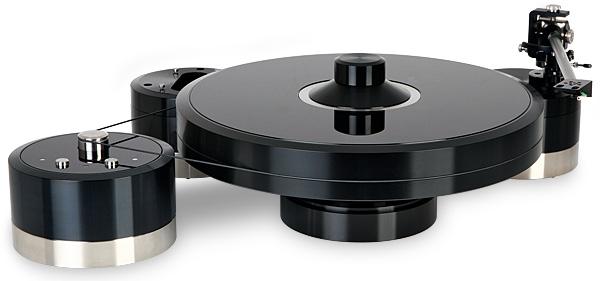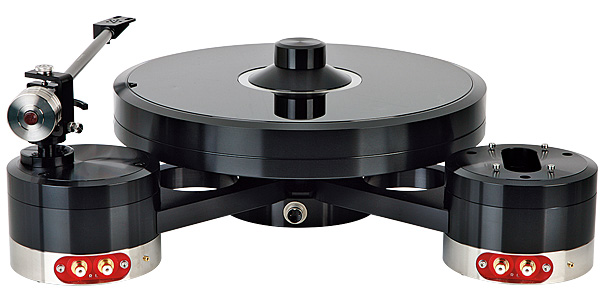Brinkmann Spyder turntable

 Sporting a unique modular design that accommodates multiple tonearms, a tube-based PSU for the motor and novel heated bearing, this super deck is far from run of the mill
Sporting a unique modular design that accommodates multiple tonearms, a tube-based PSU for the motor and novel heated bearing, this super deck is far from run of the mill
Does the world really need another high-end turntable? That’s the question Brinkmann’s Spyder has to answer, because there’s already a surfeit of fancy vinyl disc spinners sitting pretty in this high value market. This deck needs to be special in some way then, and so it proved. Costing £9795 in basic form, it’s one of two belt-driven decks in the German company’s range of hi-fi separates, sitting alongside the Balance 2 [HFN Jul ’14]. Brinkmann also makes the Bardo and Oasis direct-drive turntables, which themselves are interesting and innovative things.
Forearmed
The Spyder is most assuredly not from the traditional ‘Thorens TD150 school’ of turntable design. True, its platter is spun by a rubber belt, but that’s about all it has in common. First, it has a modular construction that accommodates up to four tonearms of up to 12in length by virtue of specially designed, bolt-on arm ‘pods’. Our deck came configured for the £3895 Brinkmann 10.5 tonearm, but it should be pointed out that, with more than two arms fitted, the Spyder would be pretty crowded, making it hard to use.
Another fascination is its novel heated bearing. Brinkmann says that in order to smoothly rotate the heavy platter, the bearing has to have minimal play. With such fine tolerances, the different coefficients of expansion of the materials used becomes an issue. This is why the bearing is heated electronically to ensure that it is largely immune to a changing ambient temperature.

Brinkmann’s so-called ‘Sinus’ motor is supplied, which is designed to reduce cogging. The arrangement of the driving coils and the neodymium magnets in combination with the drive circuit delivers 12 pulses per revolution, and these power what is effectively a 500g flywheel, giving a smooth feed to the platter. This motor can be aspirated by Brinkmann’s optional RöNT II vacuum tube power supply [see PM's Sidebar], again supplied here and costing £2995. Hence the Spyder, as tested, adds up to a cool £16,685.
The large 10kg alloy/crystal platter is driven around its edge by a thin rubber belt from the offboard motor. Its housing has to be placed 7.5cm (3in) from the edge of the platter to guarantee correct speed stability, with the deck sitting on a uniformly level surface. It sports the usual two speeds, with an LED indicator to show the motor is powered. Two top-mounted speed-trim pots sit either side of motor control buttons.
The arm pods bolt quickly to the main chassis, and contain detachable arm mounting plates, plus rear-mounted RCA phono sockets (XLR or feed-through is also available) which – if they’re specified for Brinkmann tonearms such as the 10.5 – come pre-wired to simply plug straight into the base of the arm itself. This is a neat arrangement and makes setting-up the deck less fiddly. You start by bolting an arm pod to the main chassis, gently lowering that heavy platter down into place, then aligning the motor housing. Then you connect up both the motor and bearing power supplies before installing the tonearm.
Oozing Quality
The Brinkmann 10.5 went on very smoothly with the appropriate arm plate that came with the deck, so it became a question of mounting the cartridge, balancing the arm, adjusting the cartridge alignment and VTA. The tonearm itself is a beautifully finished design. It has a claimed dynamic mass of 12g so will work well with most modern cartridges [see PM's Lab Report]. The tube is made from aluminium and stainless steel, with a so-called ‘high tech synthetic material’ also used, while the headshell has an anodised finish and is not easily detachable. Double gimbals with precision ball-bearings are used in the bearing, and there are adjustments for VTF, VTA and headshell azimuth – additionally, magnetic antiskating is fitted.
In use, this turntable feels lovely. It oozes quality and gives no impression that engineering corners have been cut. There are no creaks or groans from the belt as the deck spins up to the correct speed, although it does take a quite long time (seven seconds) to reach 33rpm, and slightly more for 45rpm – during this time the motor remains absolutely silent and never protests. The 10.5 tonearm is equally classy, with a beautifully silky feel when you hand-cue your LP tracks.
![]() Strong And Stable
Strong And Stable
There are some turntables that fly their analogue flags high, so to speak. They deliver a highly partisan view of the recording, one that’s rich, euphonic and romantic – the idea is to beguile the listener. There are others that are so forensic and analytical that it seems they secretly want to be measuring instruments. It’s as if they’d be happier working as seismographs, monitoring minute ground tremors, than playing music.
























































